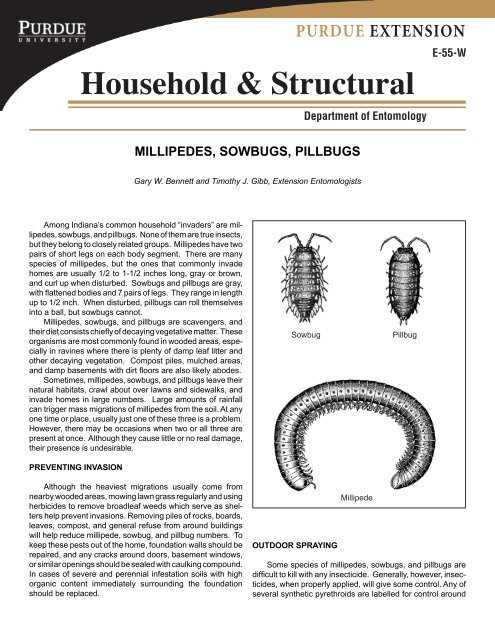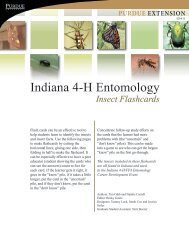Millipedes, Sowbugs, Pillbugs - Purdue Extension Entomology ...
Millipedes, Sowbugs, Pillbugs - Purdue Extension Entomology ...
Millipedes, Sowbugs, Pillbugs - Purdue Extension Entomology ...
Create successful ePaper yourself
Turn your PDF publications into a flip-book with our unique Google optimized e-Paper software.
PURDUE EXTENSION<br />
Household & Structural<br />
Department of <strong>Entomology</strong><br />
E-55-W<br />
MILLIPEDES, SOWBUGS, PILLBUGS<br />
Gary W. Bennett and Timothy J. Gibb, <strong>Extension</strong> Entomologists<br />
Among Indiana’s common household “invaders” are millipedes,<br />
sowbugs, and pillbugs. None of them are true insects,<br />
but they belong to closely related groups. <strong>Millipedes</strong> have two<br />
pairs of short legs on each body segment. There are many<br />
species of millipedes, but the ones that commonly invade<br />
homes are usually 1/2 to 1-1/2 inches long, gray or brown,<br />
and curl up when disturbed. <strong>Sowbugs</strong> and pillbugs are gray,<br />
with flattened bodies and 7 pairs of legs. They range in length<br />
up to 1/2 inch. When disturbed, pillbugs can roll themselves<br />
into a ball, but sowbugs cannot.<br />
<strong>Millipedes</strong>, sowbugs, and pillbugs are scavengers, and<br />
their diet consists chiefly of decaying vegetative matter. These<br />
organisms are most commonly found in wooded areas, especially<br />
in ravines where there is plenty of damp leaf litter and<br />
other decaying vegetation. Compost piles, mulched areas,<br />
and damp basements with dirt floors are also likely abodes.<br />
Sometimes, millipedes, sowbugs, and pillbugs leave their<br />
natural habitats, crawl about over lawns and sidewalks, and<br />
invade homes in large numbers. Large amounts of rainfall<br />
can trigger mass migrations of millipedes from the soil. At any<br />
one time or place, usually just one of these three is a problem.<br />
However, there may be occasions when two or all three are<br />
present at once. Although they cause little or no real damage,<br />
their presence is undesirable.<br />
PREVENTING INVASION<br />
Sowbug<br />
Pillbug<br />
Although the heaviest migrations usually come from<br />
nearby wooded areas, mowing lawn grass regularly and using<br />
herbicides to remove broadleaf weeds which serve as shelters<br />
help prevent invasions. Removing piles of rocks, boards,<br />
leaves, compost, and general refuse from around buildings<br />
will help reduce millipede, sowbug, and pillbug numbers. To<br />
keep these pests out of the home, foundation walls should be<br />
repaired, and any cracks around doors, basement windows,<br />
or similar openings should be sealed with caulking compound.<br />
In cases of severe and perennial infestation soils with high<br />
organic content immediately surrounding the foundation<br />
should be replaced.<br />
OUTDOOR SPRAYING<br />
Millipede<br />
Some species of millipedes, sowbugs, and pillbugs are<br />
difficult to kill with any insecticide. Generally, however, insecticides,<br />
when properly applied, will give some control. Any of<br />
several synthetic pyrethroids are labelled for control around
<strong>Millipedes</strong>, <strong>Sowbugs</strong>, <strong>Pillbugs</strong> — E-55-W<br />
2<br />
the outside perimeter. Select only formulations of these insecticides<br />
labelled for millipede, sowbug and pillbug control<br />
and follow label directions closely. Yard and garden products<br />
labelled for “crawling insect” control may also be used.<br />
Apply the spray to any infested area outdoors and as a<br />
barrier treatment on foundation walls and soil adjacent to the<br />
buildings. Use enough to thoroughly wet the surface being<br />
treated and any visible millipedes, sowbugs, or pillbugs. Repeat<br />
applications may be needed if these creatures continue<br />
to move in from surrounding areas.<br />
INDOOR CONTROL MEASURES<br />
General indoor spraying to kill any of these is seldom<br />
recommended. Any millipedes, sowbugs, or pillbugs that<br />
are found indoors can be eliminated by hand collection,<br />
vacuuming, or otherwise sweeping them up, or by spraying<br />
them directly with a household spray containing pyrethrins. A<br />
household pest control product labelled for “crawling insect”<br />
control may also be used.<br />
<strong>Millipedes</strong><br />
Be safe! Before using any insecticide, read the label,<br />
follow directions, and observe precautions.<br />
Sowbug<br />
READ AND FOLLOW ALL LABEL INSTRUCTIONS. THIS INCLUDES DIRECTIONS FOR USE, PRECAUTIONARY STATEMENTS (HAZARDS TO<br />
HUMANS, DOMESTIC ANIMALS, AND ENDANGERED SPECIES), ENVIRONMENTAL HAZARDS, RATES OF APPLICATION, NUMBER OF APPLICA-<br />
TIONS, REENTRY INTERVALS, HARVEST RESTRICTIONS, STORAGE AND DISPOSAL, AND ANY SPECIFIC WARNINGS AND/OR PRECAUTIONS<br />
FOR SAFE HANDLING OF THE PESTICIDE.<br />
Revised 5/2010<br />
It is the policy of the <strong>Purdue</strong> University Cooperative <strong>Extension</strong> Service that all persons have equal opportunity and access to its educational programs, services, activities, and facilities without regard<br />
to race, religion, color, sex, age, national origin or ancestry, marital status, parental status, sexual orientation, disability or status as a veteran. <strong>Purdue</strong> University is an Affirmative Action institution. This<br />
material may be available in alternative formats.<br />
1-888-EXT-INFO<br />

















